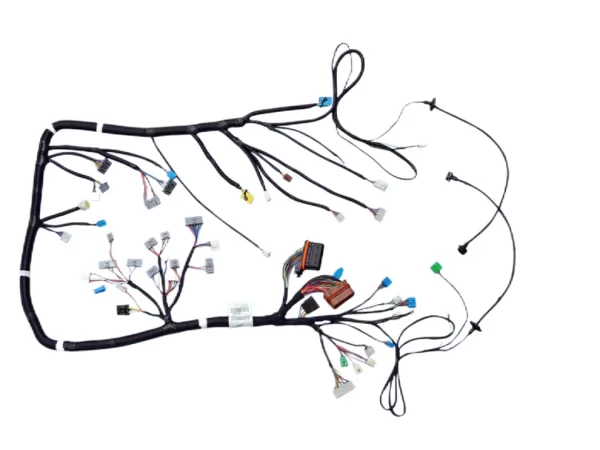In the automotive wiring harness industry, with the continuous development of automotive technology, especially electric vehicles...
Date:2024-09-03

In the automotive wiring harness industry, with the continuous development of automotive technology, especially the popularization of electric vehicles, autonomous driving technology and intelligent connected vehicles, the requirements for wiring harnesses have become more stringent and complex. The following are some of the main requirements of the automotive wiring harness industry at present:
1. High reliability
- Durability : Wiring harnesses need to maintain stable performance over time in the harsh automotive environment, including high and low temperatures, humidity, vibration, and chemical exposure (such as oil and salt spray).
- Electrical performance : The wiring harness must ensure the stability and reliability of the electrical connection to prevent interference or loss of signal transmission.
2. Lightweight
- Material selection : To reduce the overall weight of the vehicle and improve fuel efficiency or driving range, wiring harness materials tend to be lighter and thinner while maintaining strength and durability.
- Integrated design : Reduce the number and length of wiring harnesses, and reduce weight by using more efficient routing designs.
3. Electromagnetic compatibility (EMC)
- Shielding design : The wiring harness must have good anti-electromagnetic interference capabilities to prevent external electromagnetic noise from interfering with the car's electronic system, while also avoiding the electromagnetic radiation generated by the wiring harness itself from affecting other systems.
4. High pressure resistance
- High-voltage cables : As electric vehicles become more popular, high-voltage cables (such as those used in 400V or 800V battery systems) need to have higher pressure resistance and insulation performance to ensure safety.
- High Voltage Connectors : High voltage systems require specially designed connectors and protection mechanisms to prevent electric shock and short circuits.
5. Security
- Fire resistance : Wiring harness materials need to have good fire resistance and self-extinguishing properties to reduce the risk of fire.
- Protection mechanism : including short circuit protection, overcurrent protection, overheat protection, etc., to ensure that the wiring harness can still ensure safety in unexpected situations.
6. Modularization and standardization
- Manufacturability : The wiring harness design should support efficient production processes and reduce manufacturing complexity and costs. Standardized module design facilitates mass production and rapid assembly.
- Maintainability : Designed with ease of servicing and replacement in mind so that maintenance and repairs can be easily performed during the life of the vehicle.
7. Intelligence
- Data transmission : Modern automotive wiring harnesses are not only power transmission channels, but also carry a large amount of data transmission tasks, especially in autonomous driving and intelligent connected vehicles. Wiring harnesses need to support high-speed data communication (such as CAN bus, LIN bus, Ethernet, etc.).
- Power management : Power management strategies need to be considered in wiring harness design, including how to intelligently allocate and manage power resources to improve energy efficiency.
8. Environmental protection and regulatory requirements
- Environmentally friendly materials : Select halogen-free, lead-free and other environmentally friendly materials to comply with environmental regulations and sustainable development requirements.
- Recycling : Design with recyclability and reusability in mind to reduce environmental impact.
9. Customization
- Diversified requirements : Automakers have increasingly diverse requirements for wiring harnesses, especially in high-end models and smart driving cars, where wiring harnesses need to be highly customized according to specific models.
- Flexible design : Wiring harness design needs to be flexible to meet the special needs of different vehicle models, including different electrical architectures and functional requirements.
These requirements reflect the increasingly complex and diverse needs of the modern automotive wiring harness industry, while also driving continuous advancements in wiring harness design, material selection, manufacturing processes, and testing standards.